Air Freight Port Arthur Texas
Port Arthur, Texas is a bustling petrochemical hub where time-sensitive logistics are critical. AirFreight.com provides air freight and air charter services in Port Arthur, offering same day and next day delivery solutions to meet urgent shipping needs. From industrial parts to medical supplies, our expedited air cargo services keep Port Arthur’s supply chains running smoothly while optimizing for speed and reliability.
AIR FREIGHT SERVICES PORT ARTHUR
Port Arthur: Economy Overview and Logistics Background
Port Arthur lies in Southeast Texas and anchors a major industrial economy centered on oil refining, petrochemicals, and maritime trade. The city is home to the largest oil refinery in North America – the Motiva Refinery processes over 600,000 barrels of crude per day.
Port Arthur’s deep-water port is among the nation’s busiest, moving tens of millions of tons of cargo annually (36.7 million tons in 2014, ranking 20th in the U.S. by volume). This heavy concentration of energy and manufacturing activity drives demand for reliable transportation and logistics.
The Port of Port Arthur and nearby Sabine-Neches Waterway form a critical gateway for petroleum exports and imports. Trade through Port Arthur’s port of entry contributes an estimated 68,000 jobs and about $9.7 billion in GDP to the Texas economy.
Supporting industries – from chemical production to machinery manufacturing – have grown around this industrial base, benefiting from billions in new investment. With such a dynamic economy, Port Arthur’s businesses often require time-critical shipping to prevent downtime.
Here, air freight and charter services play a pivotal role in delivering parts, equipment, and products on tight deadlines, supplementing ground and sea transport.
Request a Quote Now
Add your shipment details below, and one of our professional expeditors will contact you within minutes. For immediate assistance on an urgent quote, call (832) 529-2222 with these details handy.
Port Arthur houses the Motiva Enterprises refinery, the largest refinery in the United States.
In 2014, the Port of Port Arthur handled about 36.7 million tons of cargo, making it the 20th busiest U.S. port by volume.
Companies in Southeast Texas depend on reliable air freight and air charter services to keep supply chains moving.
The oil and gas sector frequently turns to air charters for urgent deliveries of drilling and refinery equipment.
Port Arthur’s Same Day and Next Day Air Freight Options
When you partner with AirFreight.com for shipments in Port Arthur, you gain more than a service provider – you gain a trusted logistics partner committed to fast, high-performance air freight solutions. We recognize that your shipping needs can evolve quickly, so we offer flexible, scalable freight options tailored to your timeline, cargo type, and business goals.
Whether you’re moving high-value refinery parts, urgent medical supplies, or time-critical components for manufacturing, our team is equipped to get your freight to its destination fast. Our fast, flexible freight solutions are designed to keep your operations on track without compromise.
From the moment you request a quote until final delivery confirmation, our experienced team manages every detail of the shipment, minimizing disruptions. We simplify the entire process – you can focus on running your Port Arthur business while we handle all the transportation logistics in the background.
Port Arthur’s End-to-End Air Freight, Charter & Hand-Carry Services
KEY BENEFITS
Backed by a wide network of trusted air carriers and real-time communication tools, AirFreight.com ensures your critical cargo stays on track no matter the time or day.
There’s always a logistics specialist ready to respond to urgent requests, secure an aircraft, and get your freight moving immediately. Whether it’s an overnight delivery of a replacement valve for a Port Arthur refinery or a just-in-time part for a manufacturing line, we act with speed and precision to dispatch your cargo.
The moment you contact us, we mobilize our resources to identify the best routing and aircraft options, secure capacity instantly, and coordinate the entire operation. Throughout the flight, we maintain constant communication and oversight until your shipment is delivered safely and right on schedule. Our commitment to zero delays means Port Arthur businesses experience no unnecessary downtime – even on weekends or holidays, we deliver when others can’t.
EXPLORE OUR COVERAGEYou’ll receive fast responses and real-time updates from the same person every time, ensuring nothing gets lost in translation.
This streamlined approach eliminates handoffs and miscommunication, resulting in a smoother, more efficient shipping process for our Port Arthur clients. Your dedicated specialist essentially becomes an extension of your team – proactively managing the logistics, anticipating challenges, and adjusting plans as needed to keep your freight on course. By having one knowledgeable contact oversee the shipment, we can quickly address any questions or changes.
It’s a concierge level of service tailored to your business. The result is that your cargo arrives on time and in perfect condition, and you have peace of mind throughout the journey. AirFreight.com’s one-contact policy means Port Arthur shippers get personalized attention and accountability from a professional who is fully invested in the success of your delivery.
Meet the Team
Even if you have a last-minute request or face a complex logistics challenge, your Port Arthur expeditor is equipped with the industry knowledge and problem-solving skills to deliver a solution quickly and effectively.
We leverage a trusted network of carriers and decades of know-how to keep your shipment on schedule and on the optimal route. This level of dedicated expertise means less stress and more control for you. We handle the complex backend tasks (permits, cargo handling arrangements, customs if needed, etc.) so you don’t have to worry.
Throughout the shipment, you’ll receive clear, proactive communication – you’ll always know where your freight is and what’s happening. Our goal is to provide seamless support from origin to destination, so you feel confident that your Port Arthur-bound cargo is in capable hands every mile of the way. With 24/7 availability and seasoned professionals guiding each shipment, AirFreight.com is the partner you can count on for reliable results, every time.
Learn More About Us
Full visibility for your peace of mind. AirFreight.com utilizes advanced tracking technology to let you monitor your shipments 24/7/365 with complete confidence and control.
From pickup to final delivery, you have real-time visibility into your air freight’s location and status. Our system provides live data updates at every critical checkpoint, so you’ll know exactly where your cargo is at any given moment. We give Port Arthur customers full transparency on their freight journeys.
Whether you’re managing a single urgent delivery or coordinating multiple shipments, our real-time tracking platform empowers you with actionable insight. You can confidently plan around accurate ETAs, respond swiftly to any supply chain changes, and keep stakeholders informed. With AirFreight.com’s tracking and communication, Port Arthur shippers remain in control – no more guesswork or waiting in the dark for status updates.
Port Arthur By the Numbers

$84 billion
in industrial projects
The Beaumont–Port Arthur–Orange region has attracted about $84 billion in new projects and investments since 2010, fueling an industrial boom in Southeast Texas.
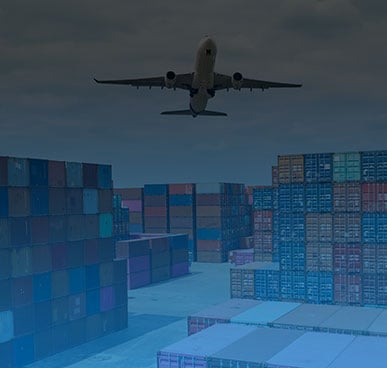
129 million
tons of cargo/year
The Sabine-Neches Waterway, which includes Port Arthur’s port, ranks as the 3rd busiest waterway in the U.S. by tonnage, moving over 129 million tons of cargo annually (surpassing even the Port of New York/New Jersey).
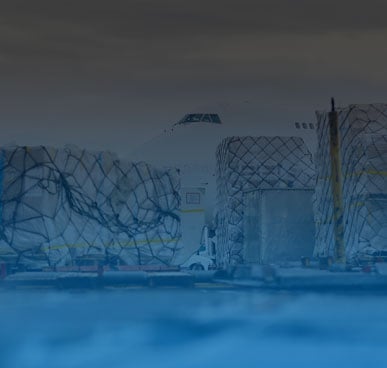
68,000
Texas jobs
International trade through Port Arthur’s port of entry supports roughly 68,000 Texas jobs, reflecting the port’s enormous economic footprint.
Your Air Freight Partner in Port Arthur, TX
As Port Arthur continues to thrive as an industrial powerhouse, having a dependable logistics partner is essential to keep production and trade flowing. AirFreight.com is proud to serve as a dedicated air freight partner for Port Arthur, TX, providing customized air cargo and air charter solutions that bolster the local economy. We understand the high stakes and tight timelines faced by Port Arthur’s businesses – whether it’s a refinery needing a replacement part same day, a manufacturing plant awaiting just-in-time components, or a marine terminal expediting a shipment for export. Our mission is to ensure that whenever the Port Arthur economy calls for speed, AirFreight.com delivers.
With our extensive North American network of airlines and expedited ground transport, we coordinate door-to-door delivery seamlessly for Port Arthur clients. A shipment can be picked up from a supplier anywhere in the country (or even Mexico/Canada) within hours and put on the next flight to Southeast Texas. We’ll often route cargo through Jack Brooks Regional Airport or other strategic airports, then arrange final-mile trucking straight to your Port Arthur facility. This integrated approach means you get a one-stop solution – a single phone call to AirFreight.com mobilizes the entire chain of transport required to get your freight from point A to point B in the shortest possible time. Our coverage spans domestic and international air cargo, so Port Arthur companies can also rely on us for global shipments, not just local or regional moves.
What sets AirFreight.com apart is our deep familiarity with Port Arthur’s industries and logistics challenges. We know that in a petrochemical city, downtime is expensive – so we prioritize speed and reliability above all. Our team has handled countless emergency shipments: from flying in a critical pump for a refinery unit to arranging a charter carrying repair parts after an unexpected outage. We’ve provided next-flight-out solutions for the energy sector, rushed medical supplies to local hospitals, and even coordinated charters for oversized project cargo when sea or ground transport timelines were too slow. Each time, we’ve seen how our quick action helped a Port Arthur business avert a crisis or seize an opportunity. Those success stories are what drive us to continuously refine our service.
Top Industries in Port Arthur

Oil & Gas
Port Arthur’s economy is dominated by oil, gas, and petrochemical companies. These firms rely on fast air freight and chartered planes to ship critical equipment and replacement parts when time is of the essence. Air charters have even been used to deliver oversized oilfield tools and valves directly to sites, underscoring the invaluable role of air logistics in the oil and gas supply chain.
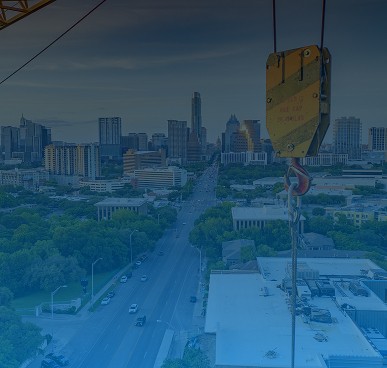
Construction
The construction industry in Port Arthur is active, especially with ongoing industrial expansions and infrastructure projects. Construction firms use air freight on occasion to quickly obtain specialized tools, machinery parts, or materials that are not available locally.

Retail
Retail businesses in Port Arthur, including national chains and local stores, typically receive goods by truck, but they turn to air freight in time-sensitive situations. For instance, a big-box retailer might use expedited air cargo to replenish high-demand inventory before a holiday rush, or a boutique shop may overnight specialty products to meet a customer request.

Manufacturing
Manufacturing in Port Arthur is largely tied to petrochemicals and refined products, as well as related machinery and fabricated metals. These manufacturers frequently depend on air freight to obtain essential parts and inputs quickly, helping maintain production timelines.

Renewables & Environment
Companies in the renewable energy sector and environmental services use air freight to move critical parts and specialized components that support clean energy projects. If a wind power project near Port Arthur needs an urgent replacement part for a turbine, or if environmental engineers require specialized monitoring equipment, shipping by air ensures these items arrive without delay.

Hospitality
Port Arthur’s hospitality sector includes hotels, restaurants, and event venues that cater to business travelers and workers (especially those coming for refinery turnarounds or port activities). Hospitality businesses use expedited shipping services to source high-value goods and essential supplies quickly, helping them meet guest needs and operational demands.
Jack Brooks Regional Airport (BPT)
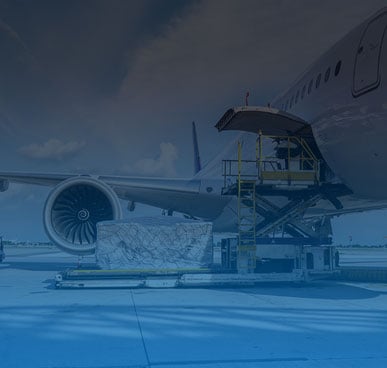
BPT
Jack Brooks Regional Airport (BPT)
Nederland, TX (Serving Beaumont–Port Arthur) – Jack Brooks Regional Airport (IATA: BPT) is the primary airport serving the Port Arthur area. The airport features two runways (approximately 6,750 and 5,070 feet long) suitable for general aviation and smaller commercial aircraft.
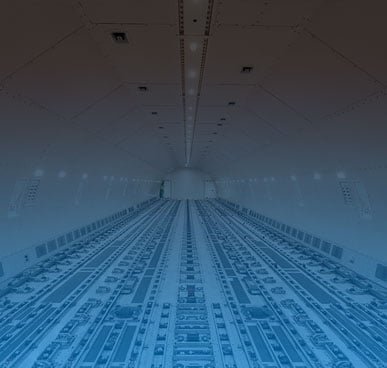
KUSA Aviation
Jack Brooks Regional Airport (BPT)
Full-Service Fixed-Base Operator – KUSA Aviation is the premier fixed-base operator (FBO) at Jack Brooks Regional Airport, offering comprehensive support for private, corporate, and charter flights.
Work with a Dedicated Single Point of Contact in Port Arthur
Every AirFreight.com client in Port Arthur benefits from working with our dedicated support team, starting from the moment you reach out. We’re available around the clock and ready to process your shipment request immediately, with no hesitation. Once you book a shipment, we spring into action to ensure a fast and efficient start – securing the necessary aircraft or cargo space and mapping the optimal route without delay. From pickup to delivery, you will receive consistent updates and clear communications.
Your Port Arthur SPOC stays fully informed on every detail of your shipment’s status and is empowered to make decisions to keep things on track. This means you, as the customer, can remain as engaged as you wish in the process.

Hi, I'm Steve
Reach out today and let's solve your urgent shipping needs. I or a member of the team will be with you from start to finish.
Aircraft Details & Interiors for Every Type of Cargo
Boeing 747-400F
Built for efficient delivery of huge loads to any corner of the globe. The wide-body design, with opening nose, large side door and cargo handling system, simplifies loading and unloading.

Top Down Cutaway
Main Deck (Top)
Lower Deck (Bottom)
Max Payload
Cubic ft: 24,115
Weight: 274,000
Side Cargo Doors
Main Deck Aft
Width: 134 in
Height: 120 in
Lower Deck Fore
& Aft
Width: 110 in
Height: 66 in
Nose Cargo Door
Width: 140 in
Height: 98 in

Range & Routes
The 747-400F has a non-stop range of approximately 5,200 miles fully loaded, making it ideal for routes throughout the 50 states and those connecting major global markets worldwide. Its long-range capabilities mean fewer stopovers and reduced transit time, lowering the risk of cargo handling delays.
A Boeing 747-400F typically flies routes connecting many major cities in the United States to hubs in Europe and Asia, including but not limited to Amsterdam, Frankfurt, Tokyo, Seoul, Shanghai, Hong Kong, Taipei, and Singapore.
Airport Requirements
The 747-400F is a large aircraft and requires airports equipped to handle its size and weight. Airports need sufficiently wide and strong runways to support the 747-400F’s maximum takeoff weight. Runway pavements must be rated to support nearly 400 tons, including the added weight during takeoff and landing maneuvers.
Taxiway Width: The aircraft’s length of 232 feet and wingspan of 211 feet mean it needs wide taxiways with large available areas to accommodate its turning radius.
Many major cargo hubs are very familiar with and already accommodate the 747-400F, although smaller regional airports may face some limitations.
Parking Apron Space: The 747-400F requires spacious parking aprons that allow for loading, unloading, and servicing. The need for access to its nose door also means parking space should not be too close to other obstacles.
Runway Requirements
Takeoff Runway Length: For a fully loaded 747-400F, a runway length of approximately 10,500 feet is generally required to safely reach takeoff speed. This requirement can vary based on altitude, temperature, and wind conditions. High-altitude airports with elevations over 8,000 feet may require longer runways due to lower air density.
Landing Runway Length: The 747-400F requires a minimum runway length of 7,500 feet, depending on its landing weight and weather conditions. Wet or dry runway conditions may increase the minimum landing distance required for safe operation.
Crew
The 747-400F is flown with a pilot and co-pilot. Additional cargo support personnel may be assigned to the flight by AirFreight.com to monitor the cargo and coordinate seamless end-to-end delivery.
KEY AIRCRAFT SPECIFICATIONS
Length
232 feet
Wingspan
211 feet
Maximum Takeoff Weight
875,000 pounds
Maximum Payload
Approximately 274,000 pounds
Range
5,200 miles with a full payload
Cargo Volume
Approximately 24,000 cubic feet
Cruise Speed
570 miles per hour or Mach 0.85
Engines
Typically equipped with four high-thrust engines like the Pratt & Whitney PW4000, General Electric CF6, or Rolls-Royce RB211
Pilatus PC-12
A small, single-engined aircraft with a generously sized aft cargo door. Intended for short-to-medium-range travel, the PC-12 can operate out of small airfields and is known for safety and reliability.

Top Down Cutaway
Main Deck
Side Cargo Door
Width: 53 in
Height: 52 in
Max Payload
Cubic Ft: 400
Weight: 2,400

Range & Routes
The Pilatus PC-12 flies a variety of domestic routes within the contiguous US. It has a non-stop range of approximately 1,700 miles at maximum payload, making it ideal for established routes or servicing remote locations throughout the US, Canada, and Mexico.
Airport Requirements
The Pilatus PC-12 is considered to be a light, turboprop utility aircraft and can take off and land at any established airport or remote areas with undeveloped infrastructure or unpaved, gravel, or grass runways.
Taxiway Width: The aircraft’s length of 49 feet and wingspan of 54 feet means it can operate on narrow taxiways.
Parking Apron Space: The Pilatus PC-12 does not require a spacious parking apron for loading, unloading, and servicing.
Ground Handling: Specialized equipment is generally not needed to load and unload cargo in this aircraft. There is enough area behind the left wing to manually load cargo, install a ramp to assist with loading wheeled cargo, or maneuver a forklift to load palleted cargo directly into the aircraft.
Fueling: Refueling may be carried out using fuel containers, fuel pumps, or fuel trucks. Fuel capacity is ultimately dependent on the weight of the payload carried by the aircraft and the range of travel required but can be up to 400 gallons.
Power and Air Support: The Pilatus PC-12 does not generally require external electrical power or support. In cases where the aircraft requires external power while the engine is off, a 28-volt ground power unit can be connected to the aircraft’s auxiliary power port.
Runway Requirements
Takeoff Runway Length: For a fully loaded Pilatus PC-12, a minimum runway length of approximately 2,500 feet is required to safely reach takeoff speed from a paved runway. This requirement will vary based on altitude, temperature, wind conditions, and runway conditions. High-altitude airports with elevations over 8,000 feet may require longer runways due to lower air density.
Landing Runway Length: The Pilatus PC-12 requires a normal minimum runway length of 2,200 feet at maximum payload. Wet, icy, unpaved, gravel, or grass runways may increase the minimum landing distance required for safe operation.
Crew
The Pilatus PC-12 is certified to fly with a single pilot, but two pilots can be used depending on the operating parameters and needs of the trip. Additional cargo support personnel may be assigned to the flight by the carrier to monitor the cargo and coordinate seamless end-to-end delivery.
KEY AIRCRAFT SPECIFICATIONS
Length
49 feet
Wingspan
54 feet
Maximum Takeoff Weight
10,400 pounds
Maximum Payload
Approximately 2,400 pounds
Range
Dependent on the model; the minimum range is approximately 1,700 miles with a full payload including crew, fuel, and cargo
Cargo Volume
Approximately 400 cubic feet
Cruise Speed
330 miles per hour
Engines
Typically equipped with one Pratt & Whitney Canada PT6A-67P turboprop engine
Antonov An-124
A massive aircraft designed from the outset for cargo. Features an opening nose and a large rear door for easy loading and unloading. Handles the largest loads of any aircraft.

Top Down Cutaway
Main Deck
Cargo Cross Section
Width: 251 in
Height: 173 in
Max Payload
Cubic ft: 36,085
Weight: 264,554
Nose Cargo Door
Width: 251 in
Height: 173 in

Range & Routes
The An-124 is a highly specialized aircraft and flies a variety of international routes based on need and the type of cargo being airlifted. It has a non-stop range of approximately 2,300 miles fully loaded, making it ideal for routes throughout the US, Canada, and Mexico, and routes connecting major global markets worldwide.
Airport Requirements
The An-124 is a very large aircraft and requires airports equipped to handle its size and weight. Airports need sufficiently wide and strong runways to support its maximum takeoff weight. Runway pavements must be rated to support nearly 400 tons, including the added weight during takeoff and landing maneuvers.
Taxiway Width: The aircraft’s length of 232 feet and wingspan of 213 feet mean it needs wide taxiways with large available areas to accommodate its turning radius.
Many major cargo hubs in the USA, such as, but not limited to, JFK, Miami, Philadelphia, Dallas/Fort Worth, LAX, Moffett Field, are very familiar with and already accommodate the An-124. Smaller regional airports may face some limitations.
Parking Apron Space: The An-124 requires spacious parking aprons that allow for loading, unloading, and servicing. The need for access to its nose and rear cargo doors also means parking space should not be too close to other obstacles.
Ground Handling: Specialized equipment may be needed to load and unload cargo, including cranes, forklifts, and custom loaders.
Fueling: Refueling may be carried out using high pressure aviation refueling systems or a pantograph fuel hydrant. Fuel capacity is ultimately dependent on the weight of the payload carried by the An-124 but may be approximately 65,000 gallons.
Power and Air Support: The An-124 contains two internal auxiliary power units. Additional ground power units may be needed to back up the internal crane systems.
Runway Requirements
Takeoff Runway Length: For a fully loaded An-124, a minimum runway length of approximately 9,800 feet is required to safely reach takeoff speed. This requirement can vary based on altitude, temperature, and wind conditions. High-altitude airports with elevations over 8,000 feet may require longer runways due to lower air density.
Landing Runway Length: The An-124 requires a normal minimum runway length of 7,800 feet at maximum payload, but a minimum landing distance of 3,000 feet might be achieved if absolutely necessary. 3,000 feet is considered extremely short for an aircraft of this size and weight and is made possible by its powerful thrust-reversing engines. Wet, icy, or unpaved runways may increase the minimum landing distance required for safe operation.
Crew
The An-124 is flown with a crew of eight: pilot and co-pilot, navigator, flight engineer, electrical flight engineer, radio operator, and two load masters. Additional cargo support personnel may be assigned to the flight by AirFreight.com to monitor the cargo and coordinate seamless end-to-end delivery.
KEY AIRCRAFT SPECIFICATIONS
Length
226 feet
Wingspan
240 feet
Maximum Takeoff Weight
886,000 pounds
Maximum Payload
Approximately 264,000 pounds
Range
2,300 miles with a full payload
Cargo Volume
Approximately 36,000 cubic feet
Cruise Speed
535 miles per hour or Mach 0.69
Engines
Typically equipped with four high-thrust Progress D-18T high-bypass turbofan engines
Boeing 777-200F
With cargo capacity approaching that of the 747-400F, this large aircraft was engineered for exceptionally long range. It’s a good choice for inter-continental delivery of large, heavy, and bulky freight.

Top Down Cutaway
Main Deck (Top)
Lower Deck (Bottom)
Max Payload
Cubic ft: 23,060
Weight: 222,075
Side Cargo Doors
Main Deck Aft
Width: 142 in
Height: 120 in
Lower Deck Fore
& Aft
Width: 106 in
Height: 67 in

Range & Routes
The 777-200F addresses a wide range of demands, including long-haul intercontinental routes to regional operations, making it an attractive choice in terms of flexibility and cost efficiency. It has a non-stop range of approximately 5,720 miles with a full payload, which allows for domestic or long-haul flights without the need for refueling, meaning reduced transit time and lower risk of cargo handling delays.
Airport Requirements
The 777-200F can operate efficiently in most modern airports and is not hindered by possible limitations that may be associated with larger aircraft in terms of ground handling and gate access.
Taxiway Width: The aircraft’s length of 209 feet and wingspan of 213 feet mean it needs wide taxiways with large available areas to accommodate its turning radius. Many major cargo hubs, domestic and worldwide, are very familiar with and already accommodate the 777-200F. Smaller regional airports may face some limitations.
Parking Apron Space: Space around the aircraft is needed for ground service equipment, such as cargo loaders, tugs, and refuelers.
Ground Handling: Standard ground handling equipment is needed to load and unload cargo such as roller equipped high-lift dollies for the upper main deck and belt or cargo loaders for the lower deck.
Fueling: Refueling may be carried out using high pressure aviation refueling systems from fuel trucks or a fuel hydrant. Capacity for the 777-200F can be up to 47,000 gallons stored in its wings and center tank but is dependent on payload and the point-to-point distance the aircraft is required to travel.
Runway Requirements
Takeoff Runway Length: At maximum payload, the 777-200F typically requires 10,000 to 12,000 feet of runway for takeoff. With lighter payloads, the aircraft may be able to take off on shorter runways. This requirement can vary based on altitude, temperature, and wind conditions. High-altitude airports with elevations over 8,000 feet may require longer runways due to lower air density.
Landing Runway Length: At maximum payload, the 777-200F typically requires a runway length between 6,000 and 8,000 feet. Wet, icy, or unpaved runways may increase the minimum landing distance required for safe operation.
Crew
The 777-200F is flown with a pilot and co-pilot. Additional cargo support personnel may be assigned to the flight by AirFreight.com to monitor the cargo and coordinate seamless end-to-end delivery.
KEY AIRCRAFT SPECIFICATIONS
Length
209 feet
Wingspan
213 feet
Maximum Takeoff Weight
765,000 pounds
Maximum Payload
Approximately 222,000 pounds
Range
5,720 miles with a full payload
Cargo Volume
Approximately 23,000 cubic feet
Cruise Speed
560 miles per hour or Mach 0.84
Engines
Typically equipped with two powerful General Electric GE90, Pratt & Whitney PW4000, or Rolls-Royce Trent 800 engines
McDonnell Douglas DC-10F
Large, long-range freighter employing an uncommon three-engine design. It’s capable of holding 23 pallets on the upper cargo deck. Big upper and lower doors support rapid loading and unloading.

Top Down Cutaway
Main Deck (Top)
Lower Deck (Bottom)
Max Payload
Cubic ft: 18,350
Weight: 101,805
Side Cargo Doors
Main Deck
Width: 140 in
Height: 100 in
Lower Deck Fore
Width: 66 in
Height: 104 in

Range & Routes
The McDonnell Douglas DC-10F has a non-stop range of approximately 4,200 miles at maximum payload, making it ideal for domestic routes and remote locations throughout the US, Canada, and Mexico.
Airport Requirements
The McDonnell Douglas DC-10F is a wide-body jet designed to take off and land from major international airports and active military bases, or deactivated military bases converted for civilian and commercial use.
Taxiway Width: The aircraft’s length of 182 feet and wingspan of 155 feet requires a taxiway designed for wide-body jets.
Parking Apron Space: A large parking apron is required to accommodate its length and wingspan while allowing enough room for service vehicles and equipment to maneuver.
Ground Handling: The aircraft requires a cargo loader to lift cargo to the main deck. Belt or cargo loaders may be used to transfer cargo on the lower deck.
Fueling: Fueling may be carried using large capacity fuel trucks or fueling systems capable of transferring large quantities of fuel. Fuel capacity is dependent on the weight of the payload carried by the aircraft and the range of travel required, but can be up to 24,000 gallons.
Power and Air Support: The aircraft is equipped with an internal auxiliary power unit to provide electrical and pneumatic power when the engines are not running. The aircraft may also be connected to a ground power unit to power electrical and pneumatic systems.
Runway Requirements
Takeoff Runway Length: The minimum runway length for a DC-10 at maximum payload is between 10,000 and 12,000 feet. This requirement will vary based on altitude, temperature, wind conditions, and runway conditions. High-altitude airports with elevations over 8,000 feet may require longer runways due to lower air density.
Landing Runway Length: The DC-10 at maximum payload requires a minimum runway length of between 6,000 and 7,000 feet. Wet, icy, unpaved, gravel, or grass runways may increase the minimum landing distance required for safe operation.
Crew
The McDonnell Douglas DC-10F is operated by a crew of three, two pilots and one flight engineer. Additional cargo support personnel may be assigned to the flight by the carrier to monitor the cargo and coordinate seamless end-to-end delivery.
KEY AIRCRAFT SPECIFICATIONS
Length
182 feet
Wingspan
155 feet
Maximum Takeoff Weight
555,000 pounds
Maximum Payload
Approximately 101,805 pounds
Range
Approximately 4,200 miles with a full payload including crew, fuel, and cargo
Cargo Volume
Approximately 18,350 cubic feet
Cruise Speed
585 miles per hour
Engines
Typically equipped with three General Electric CF6-50 turbofan engines
Airbus A300-600F
A large, wide-bodied aircraft designed to accommodate up to 28 pallets over two decks. Large primary and lower deck doors facilitate easy loading and unloading. Intended for medium-range flights.

Top Down Cutaway
Main Deck (Top)
Lower Deck (Bottom)
Max Payload
Cubic ft: 13,800
Weight: 103,600
Side Cargo Doors
Main Deck
Width: 141 in
Height: 101 in
Lower Deck Fore
Width: 106 in
Height: 66 in

Range & Routes
The A300-600F has a non-stop range of approximately 4,700 miles at maximum payload, making it ideal for domestic routes throughout the US, Canada, and Mexico.
Airport Requirements
The A300-600F is a wide-body jet designed to takeoff and land at well-equipped regional and major international airports that meet the requirements for handling wide-body aircraft.
Taxiway Width: The aircraft’s length of 177 feet and wingspan of 147 feet requires a taxiway designed for wide-body jets.
Parking Apron Space: A large parking apron is required to accommodate its length and wingspan while allowing enough room for service vehicles and equipment to maneuver.
Ground Handling: The aircraft requires a cargo loader to lift cargo to the main deck. Belt or cargo loaders may be used to transfer cargo on the lower deck.
Fueling: Fueling may be carried using large capacity fuel trucks or fueling systems capable of transferring large quantities of fuel. Fuel capacity is dependent on the weight of the payload carried by the aircraft and the range of travel required, but can be up to 25,500 gallons.
Power and Air Support: The aircraft is equipped with an internal auxiliary power unit to provide electrical and pneumatic power when the engines are not running. The aircraft may also be connected to a ground power unit to power electrical and pneumatic systems.
Runway Requirements
Takeoff Runway Length: The minimum runway length for an A300-600F at maximum payload is approximately 7,500 feet. This requirement will vary based on altitude, temperature, wind conditions and runway conditions. High-altitude airports with elevations over 8,000 feet may require longer runways due to lower air density.
Landing Runway Length: At maximum payload, the A300-600F requires a minimum runway length of 5,100 feet. Wet, icy, unpaved, gravel, or grass runways may increase the minimum landing distance required for safe operation.
Crew
The A300-600F is operated by two pilots. Additional cargo support personnel may be assigned to the flight by the carrier to monitor the cargo and coordinate seamless end-to-end delivery.
KEY AIRCRAFT SPECIFICATIONS
Length
177 feet
Wingspan
147 feet
Maximum Takeoff Weight
375,900 pounds
Maximum Payload
Approximately 103,600 pounds
Range
Approximately 4,700 miles with a full payload including crew, fuel, and cargo
Cargo Volume
Approximately 13,800 cubic feet
Cruise Speed
520 miles per hour
Engines
Typically equipped with two General Electric CF6-80C2 or Pratt & Whitney PW4000 turbofan engines
Boeing 767-200F
A medium- to long-range freighter known for being highly fuel-efficient in operation. Large side doors on the upper and lower decks and an integrated cargo handling system simplify loading and unloading.

Top Down Cutaway
Main Deck (Top)
Lower Deck (Bottom)
Max Payload
Cubic ft: 12,950
Weight: 92,500
Side Cargo Doors
Main Deck
Width: 133 in
Height: 96 in
Lower Deck Fore
Width: 70 in
Height: 68 in

Range & Routes
The 767-200F has a non-stop range of approximately 4,500 miles at maximum payload, making it ideal for domestic routes throughout the US, Canada, and Mexico.
Airport Requirements
The 767-200F is a wide-body jet designed to take off and land at well-equipped regional and major international airports that meet the requirements for handling wide-body aircraft.
Taxiway Width: The aircraft’s length of 159 feet and wingspan of 156 feet requires a taxiway designed for wide-body jets.
Parking Apron Space: A large parking apron is required to accommodate its length and wingspan while allowing enough room for service vehicles and equipment to maneuver.
Ground Handling: The aircraft requires a cargo loader to lift cargo to the main deck. Belt or cargo loaders may be used to transfer cargo on the lower deck.
Fueling: Fueling may be carried using large capacity fuel trucks or fueling systems capable of transferring large quantities of fuel. Fuel capacity is dependent on the weight of the payload carried by the aircraft and the range of travel required, but can be up to 24,000 gallons.
Power and Air Support: The aircraft is equipped with an internal auxiliary power unit to provide electrical and pneumatic power when the engines are not running. The aircraft may also be connected to a ground power unit to power electrical and pneumatic systems.
Runway Requirements
Takeoff Runway Length: The minimum runway length for a 767-200F at maximum payload is approximately 9,000 feet. This requirement will vary based on altitude, temperature, wind conditions, and runway conditions. High-altitude airports with elevations over 8,000 feet may require longer runways due to lower air density.
Landing Runway Length: At maximum payload, the 767-200F requires a minimum runway length of 5,000 feet. Wet, icy, unpaved, gravel, or grass runways may increase the minimum landing distance required for safe operation.
Crew
The 767-200F is operated by two pilots. Additional cargo support personnel may be assigned to the flight by the carrier to monitor the cargo and coordinate seamless end-to-end delivery.
KEY AIRCRAFT SPECIFICATIONS
Length
159 feet
Wingspan
156 feet
Maximum Takeoff Weight
315,000 pounds
Maximum Payload
Approximately 92,500 pounds
Range
Approximately 4,500 miles with a full payload including crew, fuel, and cargo
Cargo Volume
Approximately 12,950 cubic feet
Cruise Speed
560 miles per hour
Engines
Typically equipped with two Pratt & Whitney JT9D or Pratt & Whitney PW4000 turbofan engines
Boeing 737-300F
One of the most widely used twin-engined, medium-range aircraft, the 737 is known for efficiency and reliability. Large cargo doors allow loading oversized and bulky freight.

Top Down Cutaway
Main Deck (Top)
Lower Deck (Bottom)
Max Payload
Cubic ft: 4,600
Weight: 42,300
Side Cargo Doors
Main Deck
Width: 139 in
Height: 81 in
Lower Deck Fore
Width: 44 in
Height: 33 in

Range & Routes
The Boeing 737-300F has a non-stop range of approximately 1,820 miles at maximum payload, making it ideal for domestic routes and remote locations throughout the US, Canada, and Mexico.
Airport Requirements
The 737-300F is a narrow-body jet designed to takeoff and land from relatively short paved and concrete runways typically found at small and large commercial airports. If properly modified, the aircraft can service undeveloped areas where only gravel or unpaved runways are available.
Taxiway Width: The aircraft’s length of 110 feet and wingspan of 95 feet allows it to operate on standard commercial size taxiways with a minimum width of 75 feet.
Parking Apron Space: At the minimum, the 737-300F requires a parking apron of 120 feet x 120 feet to accommodate the external dimensions of the aircraft with additional room for ground and service equipment.
Ground Handling: The aircraft requires a scissor lift or cargo loader to lift cargo to the main deck. Belt or cargo loaders may be used to transfer cargo on the lower deck.
Fueling: Fueling may be carried using large capacity fuel trucks or fueling systems capable of transferring large quantities of fuel. Fuel capacity is dependent on the weight of the payload carried by the aircraft and the range of travel required but can be up to 5,400 gallons.
Power and Air Support: The aircraft is equipped with an internal auxiliary power unit to provide electrical and pneumatic power when the engines are not running. The aircraft may also be connected to a ground power unit to power electrical and pneumatic systems.
Runway Requirements
Takeoff Runway Length: The minimum runway length for a 737-300F at maximum payload is approximately 6,500 feet. This requirement will vary based on altitude, temperature, wind conditions and runway conditions. High-altitude airports with elevations over 8,000 feet may require longer runways due to lower air density.
Landing Runway Length: The 737-300F at maximum payload requires a minimum runway length of 6,100 feet. Wet, icy, unpaved, gravel, or grass runways may increase the minimum landing distance required for safe operation.
Crew
The Boeing 737-300F is operated by two pilots. Additional cargo support personnel may be assigned to the flight by the carrier to monitor the cargo and coordinate seamless end-to-end delivery.
KEY AIRCRAFT SPECIFICATIONS
Length
110 feet
Wingspan
95 feet
Maximum Takeoff Weight
138,500 pounds
Maximum Payload
Approximately 42,300 pounds
Range
Approximately 1,820 miles with a full payload including crew, fuel, and cargo
Cargo Volume
Approximately 4,600 cubic feet
Cruise Speed
495 miles per hour
Engines
Typically equipped with two CFM International CFM56 turbofan engines
Dassault Falcon 20
What better aircraft for getting vital parts or materials where they’re needed quickly? This famously efficient private jet has room for five pallets and a range of nearly 3,000 miles.

Top Down Cutaway
Main Deck
Side Cargo Door
Width: 73 in
Height: 55 in
Max Payload
Cubic ft: 449
Weight: 4,500

Range & Routes
The Dassault Falcon 20 has a non-stop range of approximately 2,000 miles at maximum payload, making it ideal for domestic routes and remote locations throughout the US, Canada, and Mexico.
Airport Requirements
The Falcon 20 is a medium-sized jet and can take off and land at any established airport with asphalt or concrete runways. The aircraft can land on firm grass runways and compacted dirt or gravel if special accommodations for the aircraft and procedures are made.
Taxiway Width: The aircraft’s length of 56 feet and wingspan of 54 feet allows it to operate on narrow taxiways.
Parking Apron Space: The Dassault Falcon 20 requires a parking apron large enough to accommodate the external dimensions of the aircraft with additional room for ground and service equipment.
Ground Handling: Specialized equipment is generally not needed to load and unload cargo in this aircraft aside from standard loading and service equipment such as a belt ramp, forklift, or scissor lift.
Fueling: Fueling may be carried out using fuel trucks. Fuel capacity is ultimately dependent on the weight of the payload carried by the aircraft and the range of travel required, but can be up to 1,250 gallons.
Power and Air Support: Falcon 20s are not normally equipped with onboard auxiliary power units and may require a ground power unit to power onboard systems while the engines are off.
Runway Requirements
Takeoff Runway Length: The minimum runway length for a Falcon 20 at maximum payload is approximately 5,000 feet. This requirement will vary based on altitude, temperature, wind conditions, and runway conditions. High-altitude airports with elevations over 8,000 feet may require longer runways due to lower air density.
Landing Runway Length: The Falcon 20 at maximum payload requires a minimum runway length of 3,000 feet. Wet, icy, unpaved, gravel, or grass runways may increase the minimum landing distance required for safe operation.
Crew
The Dassault Falcon 20 is operated by two pilots. Additional cargo support personnel may be assigned to the flight by the carrier to monitor the cargo and coordinate seamless end-to-end delivery.
KEY AIRCRAFT SPECIFICATIONS
Length
56 feet
Wingspan
54 feet
Maximum Takeoff Weight
28,600 pounds
Maximum Payload
Approximately 4,500 pounds
Range
Approximately 2,000 miles with a full payload including crew, fuel, and cargo
Cargo Volume
Approximately 449 cubic feet
Cruise Speed
530 miles per hour
Engines
Typically equipped with two General Electric CF700-2D engines
Cessna 406 Caravan II
A small, twin-engined turboprop aircraft for short- to medium-range deliveries. Capacity is limited but its size and versatility let it use airports close to where its cargo is produced and needed.

Top Down Cutaway
Main Deck
Side Cargo Door
Width: 47 in
Height: 46 in
Max Payload
Cubic ft: 196
Weight: 3,085

Range & Routes
The Cessna 406 Caravan II flies a variety of domestic routes within the contiguous US. It has a non-stop range of approximately 1,300 miles empty, and 830 miles at maximum payload, making it ideal for established routes or servicing remote locations throughout the US, Canada, and Mexico.
Airport Requirements
The Cessna 406 Caravan II is considered a light aircraft and can take off and land at any established airport, towered or non-towered, or remote areas with undeveloped infrastructure or dirt runways.
Taxiway Width: The aircraft’s length of 39 feet and wingspan of 50 feet means it can operate on narrow taxiways.
Parking Apron Space: The Cessna 406 Caravan II does not require a spacious parking apron for loading, unloading, and servicing.
Ground Handling: Specialized equipment is generally not needed to load and unload cargo in this aircraft.
Fueling: Refueling may be carried out using fuel containers, fuel pumps, or fuel trucks. Fuel capacity is ultimately dependent on the weight of the payload carried by the aircraft and the range of travel required, but can be up to 480 gallons.
Power and Air Support: The Cessna 406 Caravan II does not generally require external electrical power or support. In cases where the aircraft requires external power, a 28-volt ground power unit can be connected to the aircraft’s auxiliary power port.
Runway Requirements
Takeoff Runway Length: For a fully loaded Cessna 406 Caravan II, a minimum runway length of approximately 3,000 feet is required to safely reach takeoff speed. This requirement can vary based on altitude, temperature, wind conditions, and runway conditions. High-altitude airports with elevations over 8,000 feet may require longer runways due to lower air density.
Landing Runway Length: The Cessna 406 Caravan II requires a normal minimum runway length of 2,200 feet at maximum payload. Wet, icy, or unpaved runways may increase the minimum landing distance required for safe operation.
Crew
The Cessna 406 Caravan II can be flown with a single pilot. Additional cargo support personnel may be assigned to the flight by Airfreight.com to monitor the cargo and coordinate seamless end-to-end delivery.
KEY AIRCRAFT SPECIFICATIONS
Length
39 feet
Wingspan
50 feet
Maximum Takeoff Weight
9,400 pounds
Maximum Payload
Approximately 3,085 pounds
Range
Approximately 830 miles with a full payload including crew, fuel, and cargo
Cargo Volume
Approximately 196 cubic feet
Cruise Speed
240 miles per hour
Engines
Typically equipped with two Pratt & Whitney Canada PT6A-112 turboprop engines
McDonnell Douglas DC-8 71 - 73F
A large, four-engined, narrow-bodied freighter built for medium- to long-haul transportation. Loaded and unloaded through a large cargo door in the upper hold and separate forward and aft lower doors.

Top Down Cutaway
Main Deck (Top)
Lower Deck (Bottom)
Max Payload
Cubic ft: 10,400
Weight: 88,400
Side Cargo Doors
Main Deck
Width: 137 in
Height: 86 in
Lower Deck Fore
& Aft
Width: 36 in
Height: 44 in

Range & Routes
The DC-8 has a non-stop range of approximately 6,000 miles at maximum payload, making it ideal for domestic routes across the US, Canada, and Mexico.
Airport Requirements
The DC-8 is a narrow-body jet but requires a relatively long runway due to its potentially high takeoff weight at maximum payload.
Taxiway Width: The aircraft’s length of 151 feet and wingspan of 142 feet requires a taxiway with a minimum width of 75 feet for optimal maneuvering.
Parking Apron Space: A parking apron of at least 165 feet square is required to accommodate its length and wingspan while allowing enough room for service vehicles and equipment to maneuver.
Ground Handling: The aircraft requires a cargo loader to lift cargo to the main deck. Belt or cargo loaders may be used to transfer cargo on the lower deck.
Fueling: Fueling may be carried using large capacity fuel trucks or fueling systems capable of transferring large quantities of fuel. Fuel capacity depends on the weight of the payload carried by the aircraft and the range of travel required, but may be up to 24,000 gallons depending on the model.
Power and Air Support: DC-8s are not typically equipped with internal auxiliary power units to provide electrical and pneumatic power when the engines are not running and rely on a ground power units to power electrical and pneumatic systems.
Runway Requirements
Takeoff Runway Length: The minimum runway length for a DC-8 at maximum payload is approximately 8,000 to 10,000 feet. This requirement will vary based on altitude, temperature, wind conditions, and runway conditions. High-altitude airports with elevations over 8,000 feet may require longer runways due to lower air density.
Landing Runway Length: At maximum payload, the DC-8 requires a minimum runway length of 6,000 to 7,500 feet. Wet, icy, unpaved, gravel, or grass runways may increase the minimum landing distance required for safe operation.
Crew
The DC-8 F is operated by a crew of three. Additional cargo support personnel may be assigned to the flight by the carrier to monitor the cargo and coordinate seamless end-to-end delivery.
KEY AIRCRAFT SPECIFICATIONS
Length
151 feet
Wingspan
142 feet
Maximum Takeoff Weight
355,000 pounds
Maximum Payload
Approximately 88,400 pounds
Range
Approximately 6,000 miles with a full payload including crew, fuel, and cargo
Cargo Volume
Approximately 10,400 cubic feet
Cruise Speed
560 miles per hour
Engines
Typically equipped with four Pratt & Whitney CFM56 turbofan engines
Convair CV-580
An older design, this twin-engined aircraft is intended for short-to-medium-range travel. Known for good cargo capacity for its size and type, it’s a good option for deliveries to/from smaller regional airports.

Top Down Cutaway
Main Deck
Side Cargo Door
Width: 115 in
Height: 70 in
Max Payload
Cubic Ft: 2,350
Weight: 15,400

Range & Routes
The CV-580 ticks all the boxes for its versatility in the destinations it can service whether at regional airports or remote or at high and hot dirt airstrips. At maximum payload, it has a range of 1,800 miles and is primarily used for short-to-medium-haul regional cargo operations.
Airport Requirements
The CV-580 is equally capable of operating at modern airports or remote dirt airstrips at elevations up to 8,000 feet. With its turboprop engine, the aircraft makes more than enough power to tackle the environments it faces and is renowned for its short take-off and landing capabilities even in high and hot conditions.
Taxiway Width: The minimum recommended edge-to-edge width of a taxiway for the aircraft is 50 feet.
Parking Apron Space: Space around the aircraft is needed for ground service equipment and the minimum recommendation is 100 feet x 100 feet to accommodate its wingspan.
Ground Handling: The most rudimentary equipment is needed to service the aircraft. For speed and efficiency, a forklift and belt loader are recommended.
Fueling: Refueling may be carried out using fuel trucks. Capacity for the CV-580 can be up to 2,700 gallons dependent on the payload and the point-to-point distance the aircraft is required to travel.
Runway Requirements
Takeoff Runway Length: At maximum payload, the CV-580 typically requires 4,800 feet of runway for takeoff. With lighter payloads, the aircraft may be able to take off on even shorter runways. This requirement can vary based on altitude, temperature, and wind conditions. High-altitude airports with elevations over 8,000 feet may require slightly longer runways due to lower air density.
Landing Runway Length: At maximum payload, the aircraft typically requires a runway length of only 3,500 feet. Wet, icy, or unpaved runways may increase the minimum landing distance required for safe operation.
Crew
The CV-580 is typically flown with a pilot and co-pilot. Some operations may also include a flight engineer. Additional cargo support personnel may be assigned to the flight by the carrier to monitor the cargo and coordinate seamless end-to-end delivery.
KEY AIRCRAFT SPECIFICATIONS
Length
82 feet
Wingspan
92 feet
Maximum Takeoff Weight
56,000 pounds
Maximum Payload
Approximately 15,400 pounds
Range
1,800 miles with a full payload
Cargo Volume
Approximately 2,350 cubic feet
Cruise Speed
340 miles per hour
Engines
Typically equipped with Allison 501 D13D/H turboprop engines with four-blade propellers
Antonov An-26
A short-to-medium-range aircraft known for its reliability. A military-style rear door and ramp simplify loading and unloading and permit the transport of larger single items than similar aircraft can handle.
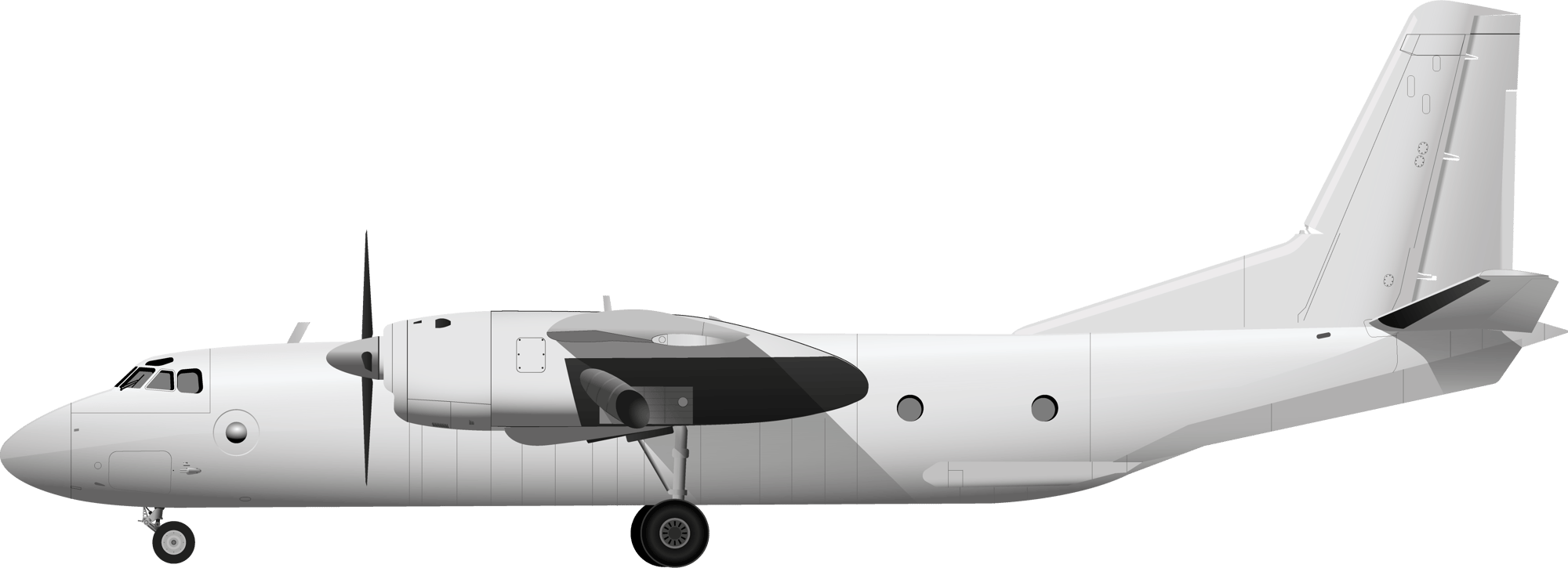
Top Down Cutaway
Main Deck
Cargo Cross Section
Main Deck
Width: 74 in
Height: 55 in
Max Payload
Cubic ft: 1,348
Weight: 12,100
Rear Cargo Door
Width: 86 in
Height: 64 in

Range & Routes
The An-26 is optimized for short-to-medium-haul cargo operations. Its capabilities shine in remote and rugged environments, where its short takeoff and landing performance is most beneficial. It has a range of 680 miles at maximum payload.
Airport Requirements
The An-26 is equally capable of operating at modern airports at sea level or unprepared airstrips and at high elevations in almost any weather. With its powerful turboprop engines and rugged design, the aircraft is comfortable working in adverse conditions.
Taxiway Width: The minimum recommended edge-to-edge width of a taxiway for the aircraft is 50 feet. It can operate on narrow taxiways of only 40 feet wide if necessary.
Parking Apron Space: If available, the recommended space around the aircraft needed for ground service equipment is 100 feet x 100 feet to accommodate its wingspan and clearance for loading and unloading at the rear of the aircraft.
Ground Handling: The aircraft can operate without extensive ground handling infrastructure. However, the most rudimentary equipment should be considered to assist those responsible for loading and unloading the aircraft. For speed and efficiency, forklifts are recommended.
Fueling: Refueling may be carried out using fuel trucks. The An-26’s fuel capacity is up to 2,430 gallons, depending on the payload and flight distance.
Runway Requirements
Takeoff Runway Length: At maximum payload, the An-24 typically requires 4,500 feet of runway for takeoff. With lighter payloads, the aircraft may be able to take off on even shorter runways. This requirement can vary based on altitude, temperature, and wind conditions. High-altitude airports with elevations over 8,000 feet may require slightly longer runways due to lower air density.
Landing Runway Length: At maximum payload, the aircraft typically requires a runway length of only 3,600 feet. Wet, icy, or unpaved runways may increase the minimum landing distance required for safe operation.
Crew
The An-26 is typically flown with two pilots, one radio operator, one flight engineer, and one navigator. Additional cargo support personnel may be assigned to the flight by the carrier to monitor the cargo and coordinate precise end-to-end delivery.
KEY AIRCRAFT SPECIFICATIONS
Length
78 feet
Wingspan
96 feet
Maximum Takeoff Weight
52,900 pounds
Maximum Payload
Approximately 12,100 pounds
Range
680 miles with a full payload
Cargo Volume
Approximately 1,348 cubic feet
Cruise Speed
270 miles per hour
Engines
Typically equipped with two Progress AI-24VT turboprop engines with four-blade propellers
Shorts SD 360
Intended for short-haul flights and able to operate from short runways, this aircraft has a good payload for its size. A square-section hold provides excellent volumetric utilization for larger loads.
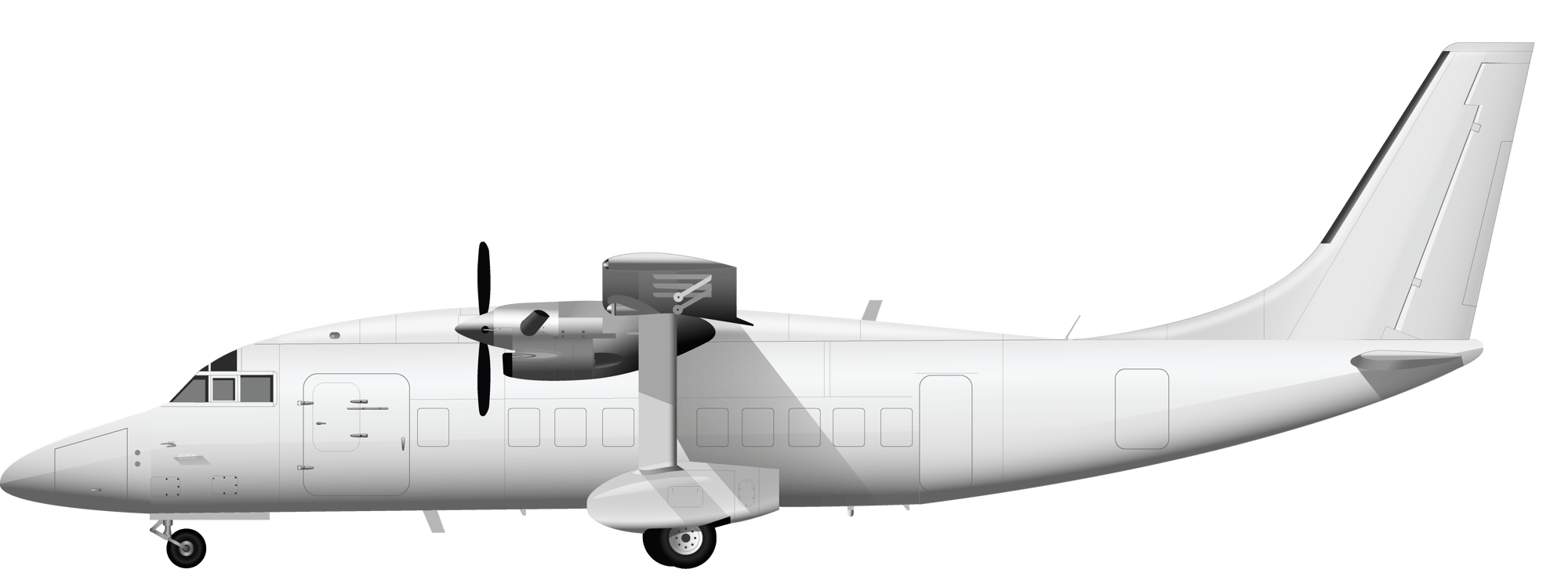
Top Down Cutaway
Main Deck
Side Cargo Doors
Width: 55 in
Height: 65 in
Max Payload
Cubic ft: 922
Weight: 3,200

Range & Routes
The SD 360 is optimized for short-haul, low-capacity routes, particularly on routes where operating larger jets would be too costly or airport runway length would make landing impossible.
Airport Requirements
The SD 360 is designed to operate out of regional airports and small airports with short runways and limited infrastructure. It can operate from regional airports with paved and unpaved runways, and rough airstrips.
Taxiway Width: The minimum recommended edge-to-edge width of a taxiway for the aircraft is 50 feet wide. It can operate on taxiways as narrow as 40 feet wide if necessary.
Parking Apron Space: If available, the recommended space around the aircraft needed for ground service equipment is 80 feet x 80 feet to accommodate its wingspan and clearance for loading and unloading.
Ground Handling: Forklifts are recommended for palletized cargo and crates, and belt loaders for small containers and loose packages. A tow tractor for pushback may be required if the aircraft is unable to proceed forward when departing the parking apron.
Fueling: Refueling may be carried out using fuel trucks. The SD 360’s fuel capacity is up to 575 gallons, depending on the payload and flight distance.
Runway Requirements
Takeoff Runway Length: At maximum payload, the SD 360 typically requires 3,800 feet of runway for takeoff. With lighter payloads, the aircraft may be able to take off on even shorter runways. This requirement may vary based on altitude, temperature, and wind conditions. High-altitude airports with elevations over 8,000 feet may require slightly longer runways due to lower air density.
Landing Runway Length: At maximum payload, the aircraft typically requires a runway length of only 2,800 feet. Wet, icy, or unpaved runways may increase the minimum landing distance required for safe operation.
Crew
The SD 360 is typically flown with two pilots. Additional cargo support personnel may be assigned to the flight by the carrier to monitor the cargo and coordinate precise end-to-end delivery.
KEY AIRCRAFT SPECIFICATIONS
Length
71 feet
Wingspan
75 feet
Maximum Takeoff Weight
12,300 pounds
Maximum Payload
Approximately 3,200 pounds
Range
990 miles with a full payload
Cargo Volume
Approximately 922 cubic feet
Cruise Speed
210 miles per hour
Engines
Typically equipped with two Pratt & Whitney Canada PT6A-65AR turboprop engines
Fairchild Metro II
A small, twin-engined aircraft for short haul delivery of urgent supplies. Loaded through a large cargo door, it can carry seven Euro-pallets with a total mass just over one ton.

Top Down Cutaway
Main Deck
Side Cargo Door
Width: 53 in
Height: 51 in
Max Payload
Cubic ft: 88
Weight: 2,755

Range & Routes
With its advantages in speed, range, and pressurized fuselage, the Metro II is best used for short-haul, high-speed regional operations where flying larger aircraft is less economical.
Airport Requirements
The Metro II is designed to operate out of regional airports with limited infrastructure, and small airports with paved, asphalt, or concrete runways. It can operate from gravel runways if properly modified for the task.
Taxiway Width: The minimum recommended edge-to-edge width of a taxiway for the aircraft is 50 feet wide.
Parking Apron Space: If available, the recommended space around the aircraft needed for ground service equipment is 60 feet x 60 feet to accommodate its wingspan and clearance for loading and unloading. It does not have a tight turning radius and requires more space to maneuver on smaller airfields.
Ground Handling: Belt loaders and carts are recommended for the speedy and efficient handling of light cargo, small containers, and loose packages. Forklifts are recommended for bulkier, heavier cargo. The aircraft does not have a steerable nosewheel, so a tow tractor for pushback may be required if the aircraft is unable to proceed forward with plenty of room when departing the parking apron.
Fueling: Refueling may be carried out using fuel trucks. The Metro II’s fuel capacity is up to 640 gallons, depending on the payload and flight distance.
Runway Requirements
Takeoff Runway Length: At maximum payload, the Metro II typically requires 4,500-5,000 feet of runway for takeoff. With lighter payloads, the aircraft may be able to take off on even shorter runways. This requirement may vary based on altitude, temperature, and wind conditions. High-altitude airports with elevations over 8,000 feet may require slightly longer runways due to lower air density.
Landing Runway Length: At maximum payload, the aircraft typically requires a runway length of only 3,500 feet. Wet, icy, or unpaved runways may increase the minimum landing distance required for safe operation.
Crew
The Metro II is typically flown with two pilots. Additional cargo support personnel may be assigned to the flight by the carrier to monitor the cargo and coordinate precise end-to-end delivery.
KEY AIRCRAFT SPECIFICATIONS
Length
59 feet
Wingspan
57 feet
Maximum Takeoff Weight
16,000 pounds
Maximum Payload
Approximately 2,755 pounds
Range
680 miles with a full payload
Cargo Volume
Approximately 400 cubic feet
Cruise Speed
320 miles per hour
Engines
Typically equipped with two Garrett AiResearch TPE-331 turboprop engines
Boeing 737-400F
The larger, longer-range version of the workhorse 737. Known for its efficiency and payload capacity, this aircraft is a popular choice for short- and medium-haul transport.
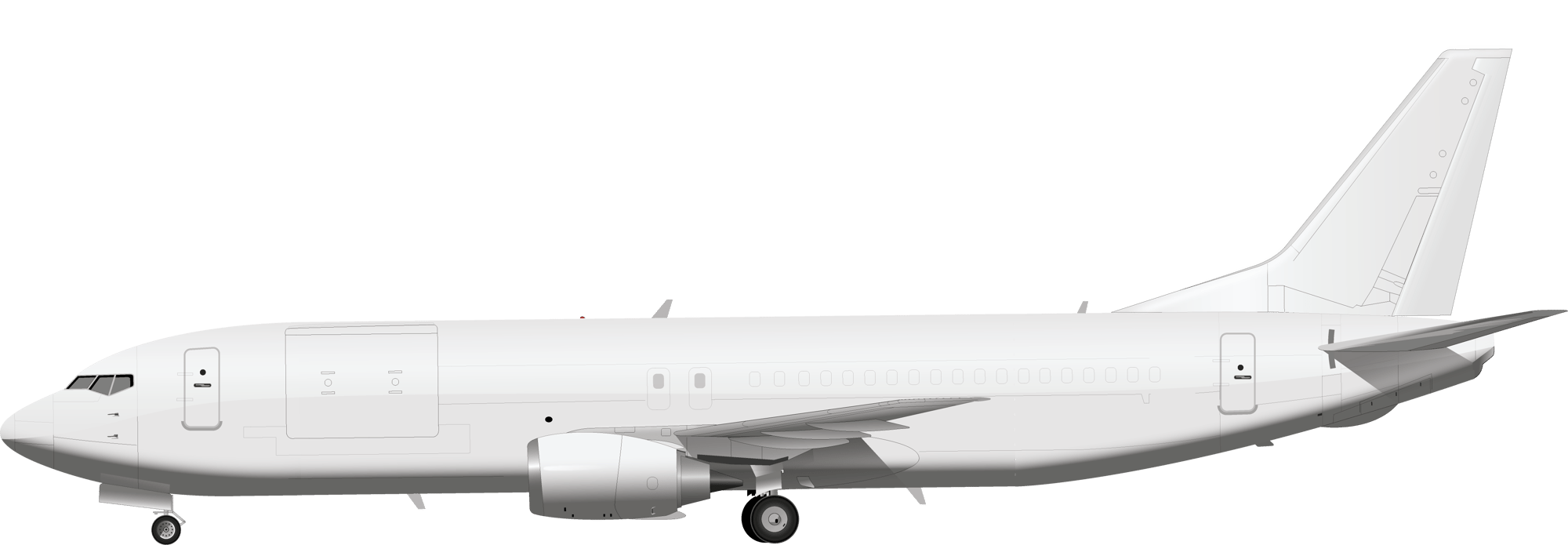
Top Down Cutaway
Main Deck (Top)
Lower Deck (Bottom)
Side Cargo Doors
Main Deck
Width: 139 in
Height: 81 in
Lower Deck Fore
Width: 44 in
Height: 33 in
Max Payload
Cubic ft: 4,600
Weight: 42,300

Range & Routes
The Boeing 737-400F has a non-stop range of approximately 2,300 miles at maximum payload, making it ideal for higher-capacity domestic routes and remote locations throughout the US, Canada, and Mexico.
Airport Requirements
The 737-400F is a narrow-body jet designed to takeoff and land from relatively short paved and concrete runways typically found at small and large commercial airports. If properly modified, the aircraft can service undeveloped areas where only gravel or unpaved runways are available.
Taxiway Width: The aircraft’s length of 120 feet and wingspan of 95 feet allows it to operate on standard commercial size taxiways with a minimum width of 75 feet.
Parking Apron Space: At the minimum, the 737-400F requires a parking apron of 150 feet x 150 feet to accommodate the external dimensions of the aircraft with additional room for ground and service equipment.
Ground Handling: The aircraft requires a scissor lift or cargo loader to lift cargo to the main deck. Belt or cargo loaders may be used to transfer cargo on the lower deck.
Fueling: Fueling may be carried out using large capacity fuel trucks or fueling systems capable of transferring large quantities of fuel. Fuel capacity is dependent on the weight of the payload carried by the aircraft and the range of travel required but can be up to 5,400 gallons.
Power and Air Support: The aircraft is equipped with an internal auxiliary power unit to provide electrical and pneumatic power when the engines are not running. The aircraft may also be connected to a ground power unit to power electrical and pneumatic systems.
Runway Requirements
Takeoff Runway Length: The minimum runway length for a 737-400F at maximum payload is approximately 8,500 feet. This requirement will vary based on altitude, temperature, wind conditions and runway conditions. High-altitude airports with elevations over 8,000 feet may require longer runways due to lower air density.
Landing Runway Length: The 737-400F at maximum payload requires a minimum runway length of 5,000 feet. Wet, icy, unpaved, gravel, or grass runways may increase the minimum landing distance required for safe operation.
Crew
The Boeing 737-400F is operated by two pilots. Additional cargo support personnel may be assigned to the flight by the carrier to monitor the cargo and coordinate seamless end-to-end delivery.
KEY AIRCRAFT SPECIFICATIONS
Length
120 feet
Wingspan
95 feet
Maximum Takeoff Weight
148,000 pounds
Maximum Payload
Approximately 45,000 pounds
Range
Approximately 2,300 miles with a full payload including crew, fuel, and cargo
Cargo Volume
Approximately 5,600 cubic feet
Cruise Speed
450 miles per hour
Engines
Typically equipped with two CFM International CFM56 turbofan engines
Antonov An-12
A medium-range air freighter with rear loading doors and ramp under a high tail. This configuration simplifies loading and unloading and enables operation from shorter runways than aircraft of similar capacity need.
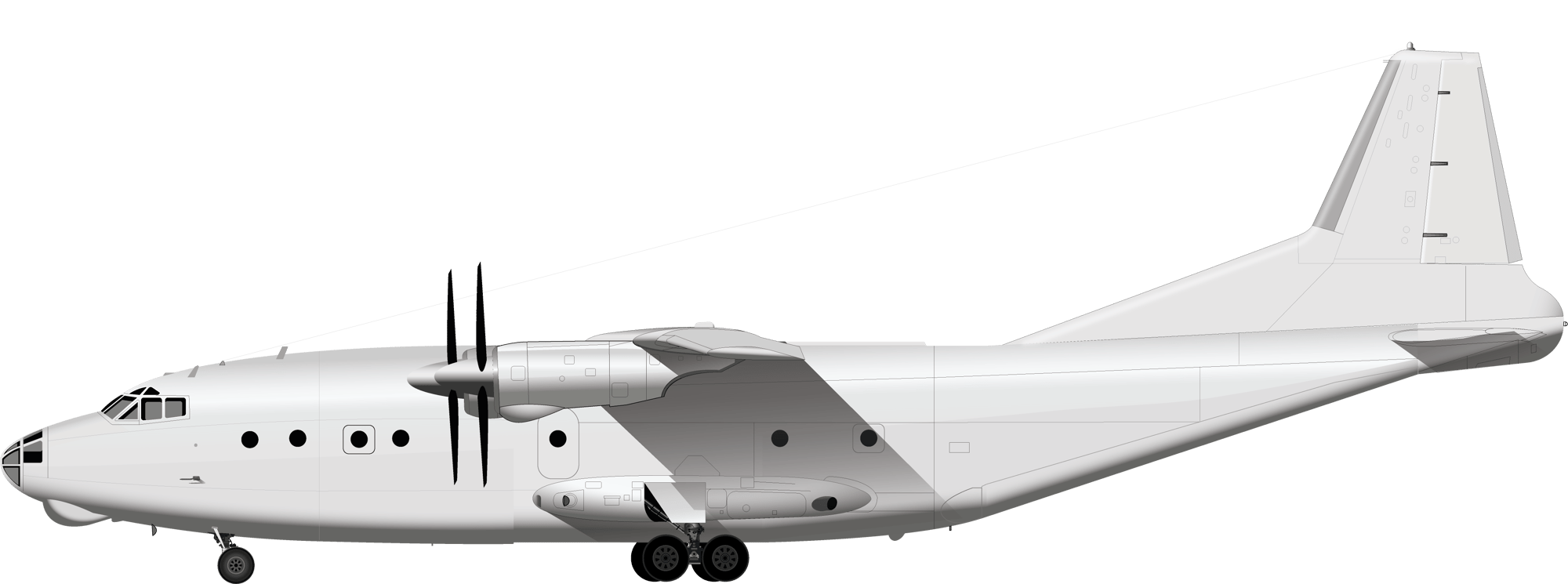
Top Down Cutaway
Main Deck
Cargo Cross Section
Main Deck
Width: 135 in
Height: 80 in
Max Payload
Cubic feet: 3,180
Weight: 44,000
Rear Cargo Door
Width: 117 in
Height: 116 in

Range & Routes
The An-12 has a non-stop range of approximately 2,200 miles at maximum payload, making it ideal for domestic routes and remote locations throughout the US, Canada, and Mexico.
Airport Requirements
The An-12 has very modest airport requirements and can operate on the shortest unpaved and undeveloped runways or paved and concrete runways typically found at small and large commercial airports.
Taxiway Width: The aircraft’s length of 109 feet and wingspan of 125 feet allows it to operate on standard commercial size taxiways with a minimum width of 75 feet.
Parking Apron Space: At minimum, the An-12 requires a parking apron of 164 feet x 135 feet to accommodate the external dimensions of the aircraft, with additional room for ground and service equipment working at the rear of the aircraft.
Ground Handling: The aircraft requires forklifts or cargo loaders to lift or roll on cargo using the ramp. Belt or cargo loaders may be used to load lighter cargo.
Fueling: Fueling may be carried out using large capacity fuel trucks or fueling systems capable of transferring large quantities of fuel. Fuel capacity is dependent on the weight of the payload carried by the aircraft and the range of travel required but can be up to 7,500 gallons.
Power and Air Support: The aircraft is not equipped with an internal auxiliary power unit and requires ground power units to power electrical and pneumatic systems when the engines are not running.
Runway Requirements
Takeoff Runway Length: The minimum runway length for the An-12 at maximum payload is approximately 8,850 feet. This requirement will vary based on altitude, temperature, wind conditions, and runway conditions. High-altitude airports at elevations over 8,000 feet may require longer runways due to lower air density.
Landing Runway Length: The An-12 at maximum payload requires a minimum runway length of 4,300 feet. Wet, icy, unpaved, gravel, or grass runways may increase the minimum landing distance required for safe operation.
Crew
The An-12 is operated by a crew of five: 2 pilots, a flight engineer, a navigator, and a radio operator. Additional cargo support personnel may be assigned to the flight by the carrier to monitor the cargo and coordinate seamless end-to-end delivery.
KEY AIRCRAFT SPECIFICATIONS
Length
109 feet
Wingspan
125 feet
Maximum Takeoff Weight
134,500 pounds
Maximum Payload
Approximately 44,000 pounds
Range
Approximately 2,200 miles with a full payload including crew, fuel, and cargo
Cargo Volume
Approximately 3,180 cubic feet
Cruise Speed
350 miles per hour
Engines
Typically equipped with 4 Ivchenko AI-20L or AI-20M turboprop engines
McDonnell Douglas DC-9 15F
A smaller, twin-engined jet built for short-to-medium-range transportation. Cargo capacity is a little over 10 tons, but the ability to use shorter runways increases the versatility of this aircraft.

Top Down Cutaway
Main Deck (Top)
Lower Deck (Bottom)
Max Payload
Cubic Feet: 4,562
Weight: 22,930
Side Cargo Door
Main Deck
Width: 136 in
Height: 81 in
Lower Deck
Fore and Aft
Width: 106 in
Height: 67 in

Range & Routes
The DC-9 has a non-stop range of approximately 1,650 miles at maximum payload, making it ideal for domestic routes and remote locations throughout the US, Canada, and Mexico.
Airport Requirements
The DC-9 has very modest airport requirements and can operate from relatively short paved and concrete runways typically found at small and large commercial airports.
Taxiway Width: The aircraft’s length of 109 feet and wingspan of 125 feet allows it to operate on standard commercial size taxiways with a minimum width of 75 feet.
Parking Apron Space: At minimum, the DC-9 requires a parking apron of 135 feet x 135 feet to accommodate the external dimensions of the aircraft and for easy access of service vehicles.
Ground Handling: The aircraft is designed with a low profile, allowing for efficient loading and unloading using forklifts, belt loaders, and cargo loaders.
Fueling: Fueling may be carried out using large capacity fuel trucks or fueling systems capable of transferring large quantities of fuel. Fuel capacity is dependent on the weight of the payload carried by the aircraft and the range of travel required but can be up to 4,900 gallons.
Power and Air Support: The aircraft is equipped with an internal auxiliary power unit located in the aft fuselage and may also be connected to ground power units to power electrical and pneumatic systems when the engines are not running.
Runway Requirements
Takeoff Runway Length: The minimum runway length for the DC-9 at maximum payload is approximately 6,000 feet. This requirement will vary based on altitude, temperature, wind conditions, and runway conditions. High-altitude airports at elevations over 8,000 feet may require longer runways due to lower air density.
Landing Runway Length: The DC-9 at maximum payload requires a minimum runway length of 5,000 feet. Wet, icy, unpaved, gravel, or grass runways may extend the minimum landing distance required for safe operation.
Crew
The DC-9 is operated by two pilots. Additional cargo support personnel may be assigned to the flight by the carrier to monitor the cargo and coordinate seamless end-to-end delivery.
KEY AIRCRAFT SPECIFICATIONS
Length
104 feet
Wingspan
90 feet
Maximum Takeoff Weight
90,000 pounds
Maximum Payload
Approximately 22,930 pounds
Range
Approximately 1,650 miles with a full payload including crew, fuel, and cargo
Cargo Volume
Approximately 4,562 cubic feet
Cruise Speed
550 miles per hour
Engines
Typically equipped with two Pratt & Whitney JT8D turbofan engines
Fairchild Metro III
An upgrade to the Metro II, thanks to a reinforced floor this has significantly higher payload, though smaller cargo volume. Like its predecessor, it’s intended for short-range, time-sensitive deliveries.

Top Down Cutaway
Main Deck
Side Cargo Door
Width: 53 in
Height: 51 in
Max Payload
Cubic feet: 385
Weight: 4,410

Range & Routes
With its advantages in speed, range, and pressurized fuselage, the Metro III is best used for short-haul, high-speed regional operations where flying larger aircraft is less economical.
Airport Requirements
The Metro III is designed to operate out of regional airports with limited infrastructure, and small airports with paved, asphalt, or concrete runways. It can operate from gravel runways if properly modified for the task.
Taxiway Width: The minimum recommended edge-to-edge width of a taxiway for the aircraft is 50 feet wide.
Parking Apron Space: If available, the recommended space around the aircraft needed for ground service equipment is 60 feet x 60 feet to accommodate its wingspan and clearance for loading and unloading. It does not have a tight turning radius and requires more space to maneuver on smaller airfields.
Ground Handling: Belt loaders and carts are recommended for the speedy and efficient handling of light cargo, small containers, and loose packages. Forklifts are recommended for bulkier, heavier cargo. The aircraft does not have a steerable nosewheel, so a tow tractor for pushback may be required if the aircraft is unable to proceed forward when departing the parking apron.
Fueling: Refueling may be carried out using fuel trucks. The Metro III’s fuel capacity is up to 640 gallons, depending on the payload and flight distance.
Power and Air Support: The Metro III does not have an internal auxiliary power unit and requires a ground power unit to power internal avionics and electrical systems when the engines are off.
Runway Requirements
Takeoff Runway Length: At maximum payload, the Metro III typically requires 4,500-5,000 feet of runway for takeoff. With lighter payloads, the aircraft may be able to take off on even shorter runways. This requirement may vary based on altitude, temperature, and wind conditions. High-altitude airports with elevations over 8,000 feet may require slightly longer runways due to lower air density.
Landing Runway Length: At maximum payload, the aircraft typically requires a runway length of only 3,500 feet. Wet, icy, or unpaved runways may increase the minimum landing distance required for safe operation.
Crew
The Metro III is typically flown with two pilots. Additional cargo support personnel may be assigned to the flight by the carrier to monitor the cargo and coordinate precise end-to-end delivery.
KEY AIRCRAFT SPECIFICATIONS
Length
59 feet
Wingspan
57 feet
Maximum Takeoff Weight
16,000 pounds
Maximum Payload
Approximately 4,100 pounds
Range
680 miles with a full payload
Cargo Volume
Approximately 420 cubic feet
Cruise Speed
320 miles per hour
Engines
Typically equipped with two Garrett AiResearch TPE-331 turboprop engines
Embraer EMB-110 Bandeirante
“Bandit” in English, this small, twin-engined Brazilian aircraft is known for its proven reliability. It’s a good choice for transporting smaller loads over short-to-medium distances.
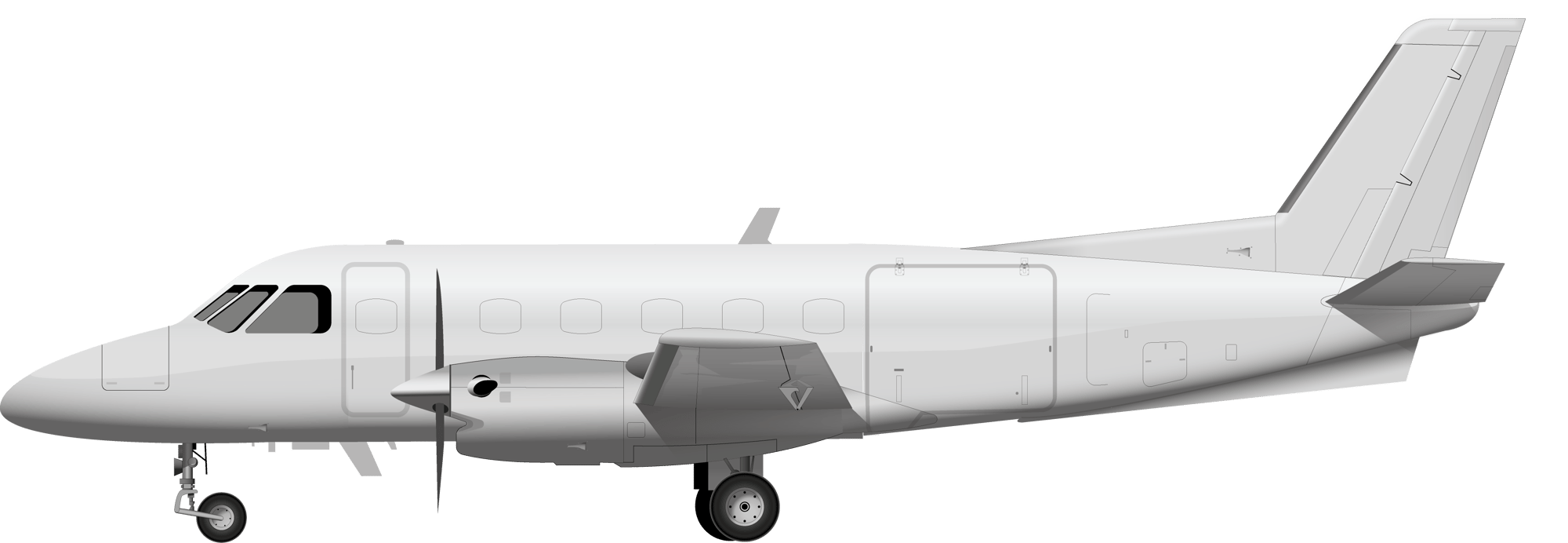
Top Down Cutaway
Main Deck
Side Cargo Door
Width: 75 in
Height: 55 in
Max Payload
Cubic Feet: 490
Weight: 3,500

Range & Routes
With its advantages in short takeoff and landing, powerful fuel-efficient engines, and ability to operate in underdeveloped areas, the EMB-110 is best used for short-haul operations where flying larger aircraft is less economical or cannot operate due to lack of necessary infrastructure.
Airport Requirements
While the EMB-110 enjoys flying from well-equipped and serviced regional airports with asphalt or concrete runways, it is at home in rugged, underdeveloped areas with limited infrastructure where it is capable of operating from compacted gravel or dirt strips with limited length and in rough conditions.
Taxiway Width: The minimum recommended edge-to-edge width of a taxiway for the aircraft is 50 feet wide.
Parking Apron Space: If available, the recommended space around the aircraft needed for ground service equipment is 80 feet x 80 feet to accommodate its wingspan and clearance for service vehicles during loading and unloading.
Ground Handling: Belt loaders and carts are recommended for the speedy and efficient handling of light cargo, small containers, and loose packages. Forklifts are recommended for bulkier, heavier cargo. The aircraft has a steerable nosewheel, so a tow tractor for pushback or tow is optional.
Fueling: Refueling may be carried out using fuel trucks. The EMB-110’s fuel capacity is up to 450 gallons, depending on the payload and flight distance.
Power and Air Support: The EMB-110 does not normally have an internal auxiliary power unit and requires a ground power unit to power internal systems when the engines are off. Battery starts for the engines can be used in cases where a ground power unit is not available.
Runway Requirements
Takeoff Runway Length: At maximum payload, the EMB-110 typically requires only 3,000 feet of runway for takeoff. With lighter payloads, the aircraft can take off on even shorter runways. This requirement may vary based on altitude, temperature, and wind conditions. High-altitude airports with elevations over 8,000 feet may require slightly longer runways due to lower air density.
Landing Runway Length: At maximum payload, the aircraft typically requires a runway length of only 2,200 feet. Wet, icy, or unpaved runways may increase the minimum landing distance required for safe operation.
Crew
The EMB-110 is flown with two pilots. Additional cargo support personnel may be assigned to the flight by the carrier to monitor the cargo and coordinate precise end-to-end delivery.
KEY AIRCRAFT SPECIFICATIONS
Length
50 feet
Wingspan
50 feet
Maximum Takeoff Weight
13,000 pounds
Maximum Payload
Approximately 3,500 pounds
Range
1,200 miles with a full payload
Cargo Volume
Approximately 490 cubic feet
Cruise Speed
255 miles per hour
Engines
Typically equipped with two Pratt & Whitney Canada PT6A-34 turboprop engines
Piper PA-31
This cargo version of the successful Piper Navajo is ideal for urgent deliveries of supplies into small airports and airfields. Twin-engined, it is known for high reliability and good performance.
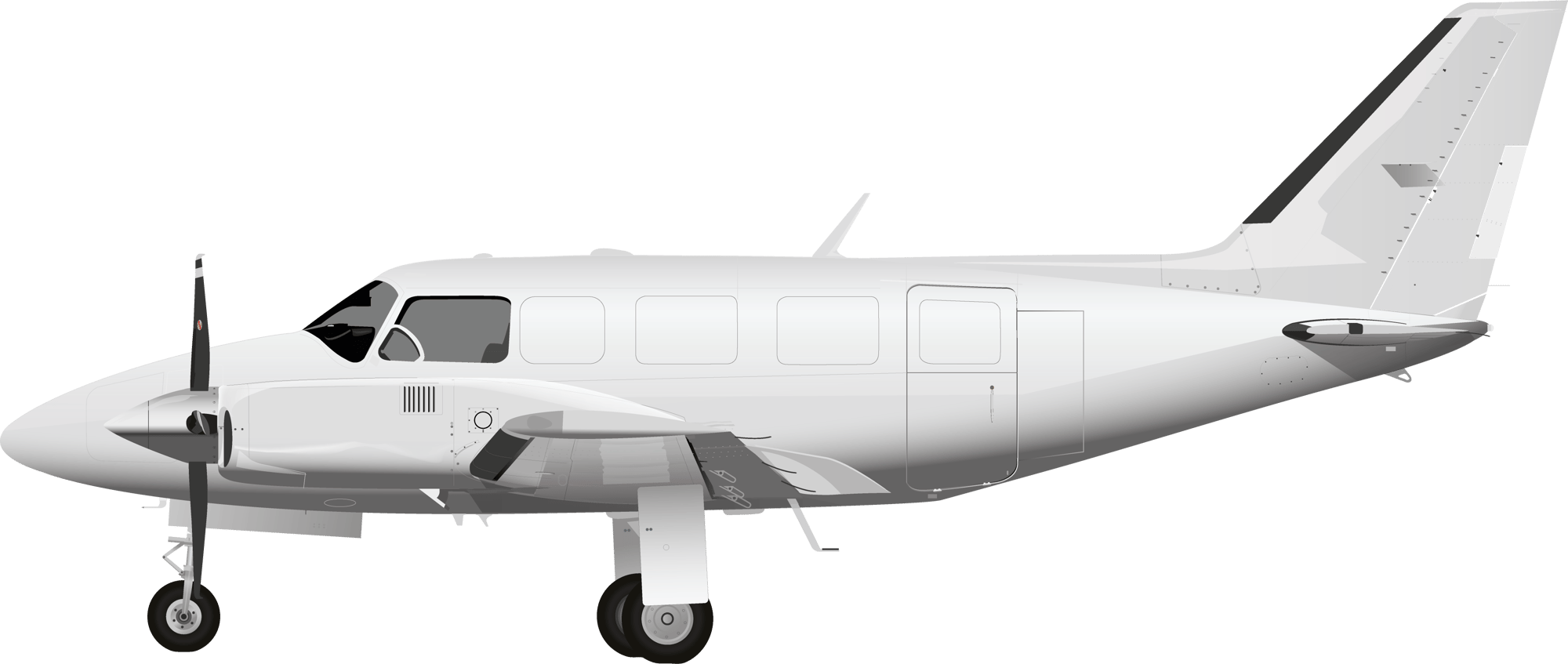
Top Down Cutaway
Main Deck
Side Cargo Door
Width: 40 in
Height: 40 in
Side Cargo Door
Door 1
Width: 26 in
Height: 40 in
Door 2
Width: 14 in
Height: 17.7 in
Max Payload
Cubic feet: 1,348
Weight: 1,200

Range & Routes
With its advantages in low-speed handling, moderate runway requirements, and ability to operate on rural or gravel strips, the PA-31 is best used for regional hauls or point-to-point hops between isolated communities.
Airport Requirements
While the PA-31 operates well from regional airports with asphalt or concrete runways, it is equally capable in rugged, underdeveloped areas with limited infrastructure. It can take off and land on compacted gravel or dirt strips with limited length and in rough conditions.
Taxiway Width: The minimum recommended edge-to-edge width of a taxiway for the aircraft is 80 feet at standard airports. However, in rural or remote locations, the aircraft can operate on taxiways as narrow as 40 to 50 feet due to its excellent handling.
Parking Apron Space: If available, the recommended space around the aircraft needed for ground service equipment is 70 feet x 70 feet to accommodate its wingspan and clearance for service vehicles for loading, unloading, and fueling.
Ground Handling: Manual handling of light cargo, small containers, and loose packages is recommended. The aircraft has a steerable nosewheel, so a tow tractor for pushback or tow is optional.
Fueling: Refueling may be carried out using fuel trucks. The aircraft’s fuel capacity is up to 190 gallons, depending on the payload and flight distance.
Power and Air Support: The PA-31 doesn’t necessarily require a ground power unit in normal operations but one could be useful in cold weather, during frequent stops to preserve battery life, or maintenance checks of powered systems.
Runway Requirements
Takeoff Runway Length: At maximum payload, the PA-31 typically requires only 1,500 feet of runway for takeoff. With lighter payloads, the aircraft can take off on even shorter runways. This requirement may vary based on altitude, temperature, and wind conditions. High-altitude airports with elevations over 8,000 feet may require slightly longer runways due to lower air density.
Landing Runway Length: At maximum payload, the aircraft typically requires a runway length of only 1,300 feet, but shorter runways are possible with lighter cargo or when empty. Wet, icy, or unpaved runways may increase the minimum landing distance required for safe operation.
Crew
The PA-31 can be flown with one pilot. Additional cargo support personnel may be assigned to the flight by the carrier to monitor the cargo and coordinate precise end-to-end delivery.
KEY AIRCRAFT SPECIFICATIONS
Length
33 feet
Wingspan
41 feet
Maximum Takeoff Weight
6,500 pounds
Maximum Payload
Approximately 1,200 pounds
Range
1,165 miles with a full payload
Cargo Volume
Approximately 140 cubic feet
Cruise Speed
240 miles per hour
Engines
Typically equipped with two Lycoming TIO-540-A turbocharged piston engines
Air Charter Freight
Whether facing ultracritical deliverydeadlines or arranging transport from aremote location, it’s vital to use the rightaircraft. Here’s what makes us special—and key information about our fleet.
Blog and Resource Center
How AirFreight.com Solved a PGA Tour Shipping Emergency
Learn how AirFreight.com located a lost shipment and helped save the PGA Golf Tour.
How AirFreight.com Saved The Farm By Solving A Major Shipping Delay
Learn how we saved a Montana-based artisanal farm thousands of dollars by expediting a shipment of perishable goods.
Expedited Shipping Vendor Comparison
We’ve done the research for you. This vendor comparison sheet breaks down how AirFreight.com stacks up against the competition.






